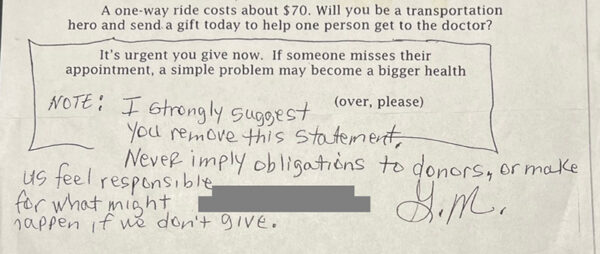(And Why It Raises More Money Than Any “About Us” Paragraph Ever Could)
The following is a hand-picked guest post from Chris Davenport. Enjoy, and you can read more about Chris below.
* * *
Great storytelling doesn’t just make you care.
It makes you feel like you belong in the story.
That’s the magic trick behind one of the most effective storytelling techniques in fundraising:
Write for the donor, not to them.
It’s a tiny shift in language that creates a massive emotional shift in the reader.
Because here’s the truth:
You’re not just telling a story.
You’re inviting the donor to step into it.
Why “TO the Donor” Storytelling Falls Flat
It sounds like this:
“We launched a new program to serve families facing housing insecurity.”
“Our staff provided shelter for 42 families last month.”
That’s writing to the donor.
You’re telling them what happened.
You’re reporting, not storytelling.
There’s no invitation. No emotion.
Just information.
The donor is outside the story, looking in — like reading a plaque at a museum.
They might nod. They might feel impressed.
But they won’t feel needed.
And if they don’t feel needed, they’re not likely to give.
Write “FOR the Donor” — and Watch What Happens
This version pulls the reader into the action — as if they were there:
“You can help a mom tuck her kids into bed tonight in a room that’s warm and safe.”
Now the donor isn’t reading a story.
They’re in the story.
They can picture it.
They can feel it.
And most importantly — they know exactly how to help.
Here’s How It Works:
The FOR Storytelling Framework
You + [emotion or physical action] + [specific outcome]
- “You’ll hand a warm meal to a child who hasn’t eaten since yesterday.”
- “You can be the reason someone whispers, ‘I finally feel safe.’”
- “You’ll flip the light switch in a shelter room that’s been dark for too long.”
The goal? Don’t just describe what happened.
Describe what the donor makes happen.
That’s a story they’ll want to be part of.
Tiny Scene, Big Emotion
Want to take it one step further? Add a detail that locks the scene in their memory:
Instead of:
“You’ll provide winter coats for kids in need…”
Try:
“You’ll zip up a puffy red coat around a 6-year-old named Eli — just before the snow hits.”
That’s not just storytelling.
That’s cinematic fundraising.
How to Use This in Real Life
Next time you write an appeal, a thank-you letter, or a donation page:
Look for the sentences that begin with:
- “We need…”
- “Our goal is…”
- “This program will…”
Rewrite just one using the FOR formula.
Make the donor the one doing the action.
Make them the reason something good happens.
That’s the storytelling switch that unlocks generosity.
Final Word
This isn’t fluff.
This is one of the most powerful storytelling techniques you can learn as a fundraiser:
Write the story so your donor feels like they’re in it.
Not watching.
Not applauding.
Acting.
That’s how you turn a reader into a giver.
And a giver into a champion.
Want more storytelling techniques like this?
You’ll find a whole library of bite-sized wins over in the QuickApply Collection—smart, fast strategies to help you write stories that move people and raise more money. No fluff. Just tools that work.
Go poke around. Your next breakthrough might be one click away.
* * *
Steven says: “Chris Davenport is the founder of the Nonprofit Storytelling Conference – the most practical and impactful fundraising conference there is. Chris has trained thousands of Fundraisers to use story-driven communication to raise more money and build deeper relationships with donors. Check out his ‘QuickApply’ library if you’d like to know more, and I hope to see you at this year’s conference!”










